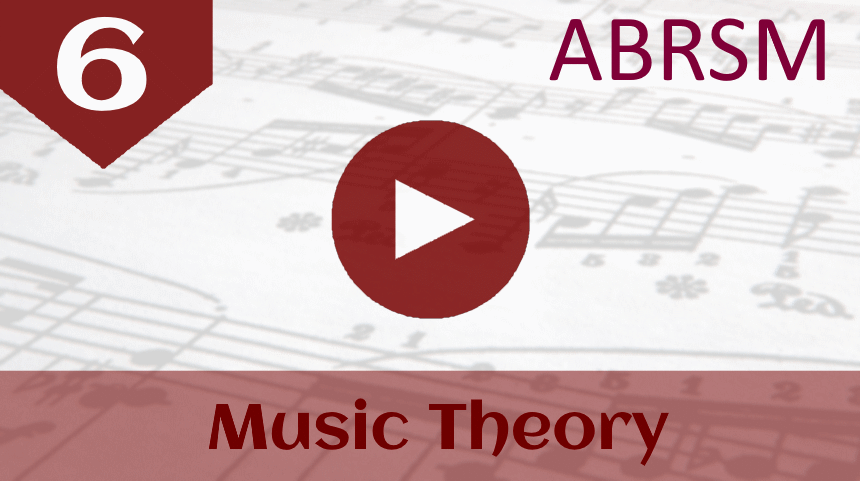If you have taken ABRSM grade 5 theory recently, you will have probably taken the online exam. You will find grade 6 quite a different experience, as 50% of the paper requires you to write music yourself. If you have not done much handwriting of music before, be sure to do plenty of practice to make sure your notation is neat, legible and accurate.
You will find a large number of free lessons on this website, or get the full ABRSM Grade 6 Music Theory course in your preferred format:
On this page you can find the syllabus information, and links to the free ABRSM Grade 6 Music Theory lessons available on this site.
ABRSM Grade 6 Music Theory Lessons
Rhythm, Pitch and Key
- Syncopation
- Note Names in Other Languages
- Major Scales with 7 Sharps/Flats
- Minor Scales with 7 Sharps/Flats
Chords
- Chord V7 – The Dominant 7th
- Chord VI – The Submediant
- Chord III – The Mediant
- Chord VII – The Leading Note
- Chord II7 (Supertonic 7th)
- Chord v (Minor Dominant)
- Chord IV (Major Subdominant; Melodic Minor)
- Tierce de Picardie
- Chord Inversions in Music
Chord Progressions
- Common Chord Progressions
- The Cadential 6/4
- Passing Chords
- Other 6/4 Progressions
- Interrupted Cadence
- Progressions and Inversions
Decoration and Ornaments
- Unaccented Passing Notes
- Accented Passing Notes
- Auxiliary Notes
- Appoggiaturas
- Anticipations
- Changing Notes
- Pedals
- Chromatic Decoration
- Writing Out Ornaments (ABRSM Grade 6)
Voice Leading
- Conjunct and Disjunct Motion
- Leading Notes and 7ths
- Augmented and Diminished Intervals
- Consecutive 5ths and Octaves
Q1a
SATB Harmony
Figured Bass
Q1b
Q2
Modulation
Composition
- Composition (ABRSM Grade 6)
- Implied Harmony
- Motifs, Sequences and Imitation
- Instrument Ranges
- Composition Questions (ABRSM Grade 6)
Style and Form
Orchestration
General Knowledge
- Transposition (ABRSM Grade 6)
- Intervals in an Orchestral Score
- Chords and Key in a Score
- Grade 6 Musical Terms Quiz
Practice Test
About the ABRSM Grade 6 Music Theory Exam Syllabus
You will gain an in depth understanding of voice leading and harmony first, which will then allow you tackle question 1a of the exam paper. After this, we will learn about the conventions of figured bass, which will allow you to tackle question 1b and question 2.
The principles of implied harmony and modulation will enable you to tackle question 3, which is composition (but your knowledge of voice leading and harmony will also be necessary here).
Finally, we look at other aspects of theory which can come up in questions 4 and 5, which are general questions based on chamber and orchestral scores.
You will find the exam much easier if you are able to hear music in your head (in the same way that you can read words in your head). This is a skill which takes practice, but if you spend a few minutes each day you will quickly make progress.
I also highly recommend purchasing ABRSM past papers before sitting an actual exam. These can be obtained from shop.abrsm.org, Amazon or your local sheet music reseller.
ABRSM Syllabus (Grade 6)
As in preceding grades, with the addition of:
- The use of 5/3, 6/3 and 6/4 chords on any degree of the major or minor (harmonic and melodic) scale.
- The recognition of the dominant seventh chord in root position, first, second and third inversions, in any major or
minor key. - The supertonic seventh chord in root position and first inversion, in any major or minor key.
- Figuring for all the above chords.
- Modulation
- Cadences
- Ornamentation and melodic decoration, which might include passing notes, auxiliary notes, appoggiaturas, changing notes and notes of anticipation.
Questions will cover:
- Writing specified chords for voices in four parts or for keyboard (at the candidate’s choice) above a given bass part of about four bars.
- The indication of suitable chords for the accompaniment of a diatonic melody of about eight bars in any key, using any recognised method of notation, or, at the candidate’s choice, the provision of a bass to a given melody, adding figures to indicate the intended harmonies.
- Composition of a melody for a specified instrument (a choice will be provided), using a given opening. Modulation to the dominant, subdominant, relative major or relative minor may be required.
- Questions on short extracts of music written for piano or in open score for voices or for any combination of instruments and/or voices, designed to test the candidate’s knowledge of the elements and notation of music, including the realisation of ornaments, the identification and notation of underlying harmonic structure, phrase structure, style, performance, and on the voices and instruments for which the works were written.
Read the ABRSM syllabus here.


